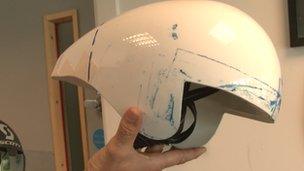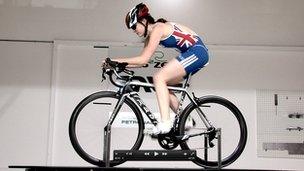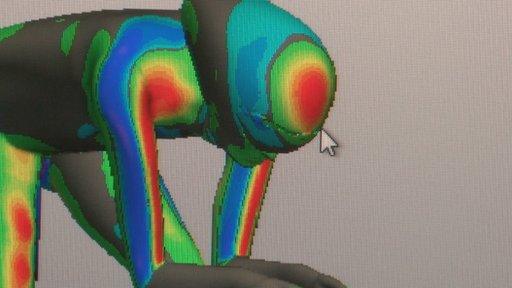Tour de France: The race to find the extra inch
- Published
Simon Smart, of Smart Aero Technology, explains the sophisticated process of making cyclists as fast as possible.
"Life's this game of inches. One half-second too slow, too fast and you don't quite catch it. The inches we need are everywhere around us."
So said Al Pacino, in his role as Tony D'Amato in the 1999 film Any Given Sunday.
He was talking about American football, but the sentiment could apply to any competitive sport - especially cycling, where inches mean champions, yellow jerseys and a place in history.
And so it was, in stage four of this year's Tour de France, when the Orica GreenEdge team emerged victorious.
After 26 minutes spent cycling 25km, it all came down to less than a few tenths of a second.
Simon Smart had a lot to do with that success.
Following 14 years working in Formula One, he brought his biomechanical expertise to cycling and founded Smart Aero Technology - a company based in Brackley, an English town not far from Silverstone racing circuit, and one that lives and breathes motorsport.
Mr Smart designed the Scott Plasma, the bike ridden by the Orica GreenEdge team as it triumphed in Nice. The team also used one of Smart Aero's helmets, another crucial factor in shaving off valuable time.
'Tiny details'
Like Al Pacino's football coach, Mr Smart has made finding those added inches his obsession, seeking out the smallest of differences to discover what the industry calls marginal, or incremental, gains.
Find enough of them - a tweak to a pedal design here, a smooth lump on a helmet there - and you have a winner on your hands.
"You're looking for the tiny details," he told the BBC.
"You're looking to change the shape of something by maybe 0.1mm, and it's making a difference."
Every cycling component, be it the frame, wheels or even the cyclists themselves, is slowing a rider down in some way. The goal, of course, is to minimise that speed loss - known to the experts as reducing drag.
Discovering where drag occurs is a highly complex - and expensive - process.
.jpg)
The Orica GreenEdge team triumphed in the stage four time trial
"The trick there is in developing the tools that can measure the smallest of differences," Mr Smart explains. "Once you can measure the small differences, you can spot the small gains and add them up."
Core to that discovery process is the use of technology known as Computational Fluid Dynamics (CFD).
After designing a bike using computer-aided design software (CAD), Simon is able to simulate what the bike will be like to ride, with the CFD software producing something akin to a heat map of drag.
If the CFD shows areas where the air flow faces greater resistance, it means the rider will be slowed down in real life too.
But the experimentation doesn't end there.
"The downside of that is that it's not the real world, it's on a computer, and it doesn't always give you the true answers."
Into the tunnel
Being at the home of motorsport has its advantages when you're in need of real-world analysis.
On the same site as Smart Aero sits a research and development hub owned by Mercedes, part of which is a wind tunnel used to test the aerodynamics of, among other things, Formula One cars.

Helmet designs go through various incarnations before being fully manufactured
Specialized, a US firm, and one of Smart Aero's competitors, recently invested in its very own in-house wind tunnel - one which is big enough to accommodate several bikes and riders at a time.
As well as testing out the high-end bikes, Specialized also plans to put some of its cheaper models, even commuter bikes, into the tunnel.
"Being able to put multiple riders in isn't good just for road studies - we're very keen to do some commuter draft testing, to see the optimal way to draft off of your buddy commuting to work," said Mark Cote, performance, road and tri-manager at Specialized, in an interview with Cyclist magazine, external.
The fact that this high-end technology is being used to help commuter bikes is a reflection on the cycling industry as a whole.

The wind tunnel is the best way to experiment with new designs
Unlike other sports, such as Formula One, the bikes in the Tour de France have to be full commercial products that are on the market.
It means a designer can't simply make a bike that's perfect for one rider in set conditions. It's a big challenge, but one that means the bikes ridden by the pros - and the technology that helped make them - filter down to enthusiasts the world over.
For Specialized, having their own wind tunnel is about helping the collaborative designing process, Mark Cote says.
"Having an on-site wind tunnel means instead of three to five engineers and product managers going to a wind tunnel test for an idea, literally the entire team can walk down the street and offer up ideas.
"So a graphic designer, [who] maybe has never been in a wind tunnel, can see something and say, 'Hey, why don't you do this?' and since we look at this stuff all day, there are often new ideas that come out this way."
Stretchy socks
By far the most disruptive element in causing drag is one fairly critical to the bike's operation: the rider.
By and large, people aren't naturally aerodynamic, and so great efforts are made to smooth out the human body to minimise the adverse effect.
Many riders will wear skin suits, tailored exactly to their shape, made from fabrics that are known to react in certain ways at higher speeds.
"It's not the easiest thing to make," says Simon Smart. "Because you're trying to avoid the seams that can interrupt the airflow and cause early separation, which increases the drag of the body massively."
On a cyclist's feet - below freshly-shaven legs - can be found a pair of overshoes, stretchy plastic-like socks that slip over the rider's shoes, the buckles of which can contribute to drag.

Computational Fluid Dynamics allows for the analysis of drag on a cyclist
Special socks alone won't win a Tour de France, but it is perhaps the simplest manifestation of the marginal gain theory.
British cycling's performance director Dave Brailsford, who helped mastermind Team GB's world-beating display at London 2012, made it his obsession to find the 1% gains in every aspect of competition.
"There's fitness and conditioning, of course, but there are other things that might seem on the periphery, like sleeping in the right position, having the same pillow when you are away and training in different places," he told the BBC not long after his Olympic success.
"Do you really know how to clean your hands? Without leaving the bits between your fingers?
"They're tiny things, but if you clump them together, it makes a big difference."
Or, as a slightly-censored Al Pacino put it: "We know, when we add up all those inches, that's gonna make the difference between winning and losing."
Follow Dave Lee on Twitter @DaveLeeBBC, external.
- Published26 July 2012